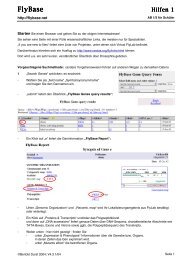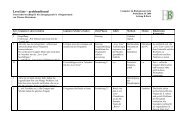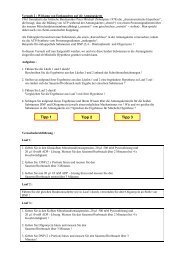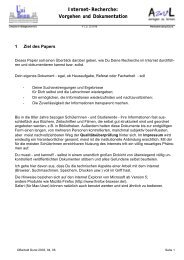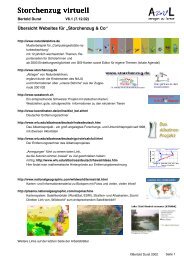Arbeitsblätter zu NCBI-Datenbanken - Azul-online.de
Arbeitsblätter zu NCBI-Datenbanken - Azul-online.de
Arbeitsblätter zu NCBI-Datenbanken - Azul-online.de
Create successful ePaper yourself
Turn your PDF publications into a flip-book with our unique Google optimized e-Paper software.
<strong>NCBI</strong> - Recherche in genetischen <strong>Datenbanken</strong><br />
Bertold Durst<br />
Ein Unterrichtsvorschlag <strong>de</strong>r Fachdidaktik Biologie, Universität Bonn<br />
<strong>zu</strong> www.ncbi.nih.gov/<br />
vgl. PedigreeLab bei www.lehrer-<strong>online</strong>.<strong>de</strong><br />
aus: OMIM-Datenbank http://www.ncbi.nlm.nih.gov/entrez/dispomim.cgi?id=163890<br />
Weg: Genes and disease > Chromosome 1 > Parkinson > OMIM<br />
<strong>zu</strong> „Parkinson 1 = SNCA!?“ Text 1<br />
Schnell wechseln<strong>de</strong> Erkenntnisse in 5 Jahren!<br />
MOLECULAR GENETICS<br />
Polymeropoulos et al. (1996) <strong>de</strong>monstrated that the Parkinson disease phenotype in a large family of Italian<br />
<strong>de</strong>scent could be mapped to 4q21-q23. Designated Parkinson disease type 1 (PARK1; 601508), the disor<strong>de</strong>r in this<br />
family was well documented to be typical for Parkinson disease, including Lewy bodies, with the exception of a relatively<br />
early age of onset of illness at 46 +/- 13 years. In this family, the penetrance of the gene was estimated to<br />
be 85%. Since the SNCA gene maps to the same region, it was consi<strong>de</strong>red an excellent candidate for the site of<br />
the mutation in PARK1. In the Italian family, Polymeropoulos et al. (1997) found a G-to-A transition in nucleoti<strong>de</strong><br />
209 of the SNCA gene, which resulted in an ala53-to-thr substitution (A53T; 163890.0001). The same A53T mutation<br />
segregated with the Parkinson disease phenotype in 3 Greek kindreds. In these families also, the onset of the<br />
disease occurred relatively early.<br />
Farrer et al. (1998) sequenced the entire coding region of the SNCA gene in 6 familial cases of autosomal dominant<br />
Parkinson disease and 2 cases of amyotrophic lateral sclerosis-parkinsonism/<strong>de</strong>mentia complex of Guam<br />
(105500). They sequenced exon 4 in 5 additional cases of familial disease and screened for the A53T mutation in<br />
40 cases of idiopathic Parkinson disease, 3 cases of multisystem atrophy, and 15 cases of Lewy body <strong>de</strong>mentia. In<br />
no case did they find a mutation in the SNCA gene. Farrer et al. (1998) suggested that the A53T mutation in alphasynuclein<br />
may be a harmless variant in linkage disequilibrium with the true pathogenic mutation.<br />
Scott et al. (1997) exclu<strong>de</strong>d linkage to alpha-synuclein in 94 multiplex (at least 2 sampled affecteds with Parkinson<br />
disease) families. Scott et al. (1999) screened the translated exons of the SNCA gene for the A53T mutation in 356<br />
affected individuals from 186 multiplex families with Parkinson disease. One Greek-American family segregated<br />
this mutation as an autosomal dominant trait, giving a frequency for this mutation of 1 in 186, or 0.5%. The phenotype<br />
in this family was consistent with the other Greek and Italian families reported with this mutation. Other than<br />
autosomal dominant inheritance and wi<strong>de</strong>r intrafamilial variation in age at onset, there were no significant differences<br />
in the phenotype in this family and the other families in the data set. Members of the family remaining in Greece<br />
had been reported by Markopoulou et al. (1995). Scott et al. (1999) conclu<strong>de</strong>d that the SNCA gene is not a major<br />
risk factor in familial Parkinson disease.<br />
Aufgabe:<br />
Schreiben Sie in einer Tabelle die Anzahl und Herkunft <strong>de</strong>r von <strong>de</strong>n verschie<strong>de</strong>nen Forschern untersuchten<br />
Personen übersichtlich auf.<br />
Tragen Sie die jeweiligen Aussagen über Gene und Auftreten <strong>de</strong>r Krankheit ein.<br />
Suchen Sie in <strong>de</strong>n <strong>NCBI</strong>-<strong>Datenbanken</strong> nach an<strong>de</strong>ren Genen, die mit Parkinson verbun<strong>de</strong>n sind und erstellen<br />
Sie eine Übersicht über die Erbgänge und weitere für Sie verständliche Aussagen <strong>de</strong>r Texte in OMIM!<br />
Bertold Durst 2002<br />
Seite 1
<strong>NCBI</strong> - Recherche in genetischen <strong>Datenbanken</strong><br />
www.ncbi.nih.gov/<br />
vgl. PedigreeLab bei www.lehrer-<strong>online</strong>.<strong>de</strong><br />
aus: OMIM-Datenbank http://www.ncbi.nlm.nih.gov/entrez/dispomim.cgi?id=261600<br />
<strong>zu</strong> Phenolketonurie: Text 2<br />
Historische Herkunft und Verteilung in verschie<strong>de</strong>nen Populationen<br />
POPULATION GENETICS<br />
Peculiarities in the distribution of phenylketonuria have been noted. The disor<strong>de</strong>r is rare in Ashkenazi Jews (Cohen<br />
et al., 1961; Centerwall and Neff, 1961). Carter and Woolf (1961) noted that of the cases seen in London and presently<br />
living in southeast England, a disproportionately large number had parents and grandparents born in Ireland<br />
or West Scotland. The frequency at birth in northern Europeans may be about 1 per 10,000 (Guthrie and Susi,<br />
1963). In Kuwait, Teebi et al. (1987) found 7 cases of PKU among 451 institutionalized mentally retar<strong>de</strong>d persons<br />
(1.9%).<br />
Saugstad (1975) <strong>de</strong>termined the frequency and distribution of PKU in Norway and conclu<strong>de</strong>d that the PKU gene<br />
was probably of Celtic origin, i.e., was brought from Ireland and Scotland (which have the highest frequency of<br />
PKU) with wives and slaves of the Vikings. Rh, Kell, and PGM-1 types support the suggestion. PKU was first discovered<br />
in Norway by Folling (1934).<br />
From the increase in frequency of parental consanguinity, Romeo et al. (1983) estimated that the frequency of PKU<br />
in Italy is between 1 in 15,595 and 1 in 17,815 (according to 2 different formulas), values not greatly different from<br />
that <strong>de</strong>rived from screening programs (about 1 in 12,000). Flatz et al. (1984) conclu<strong>de</strong>d that the PKU gene was<br />
1.37 times more frequent in prewar northeastern Germany than northwestern Germany.<br />
DiLella et al. (1986) cited an inci<strong>de</strong>nce of 1 per 4,500 in Ireland and 1 per 16,000 in Switzerland with an average inci<strong>de</strong>nce<br />
of about 1 per 8,000 in U.S. Caucasians. The PKU gene has been consi<strong>de</strong>red to be Celtic in origin. Perhaps<br />
surprisingly, DiLella et al. (1986) found the splice donor site mutation of intron 12 in Denmark, England, Ireland,<br />
Scotland, Switzerland, and Italy. Furthermore, the association with RFLP haplotype 3 was preserved in these<br />
populations. This is a difficult finding to explain in population genetics terms that are compatible with <strong>de</strong>mographic<br />
history.<br />
Aufgabe:<br />
Erstellen Sie eine tabellarische Übersicht über die Herkunft und Anzahlen <strong>de</strong>r in diesem Ausschnitt genannten<br />
Personengruppen.<br />
Welche Argumente tragen die Forscher vor, um eine historische Herkunft <strong>de</strong>r Phenylketonurie <strong>zu</strong> erschließen?<br />
Hinterfragen Sie aus historischen Quellen die Aussage über<br />
„irische und schottische Frauen und Sklaven <strong>de</strong>r Wikinger“!<br />
Bertold Durst 2002<br />
Seite 2
<strong>NCBI</strong> - Recherche in genetischen <strong>Datenbanken</strong><br />
www.ncbi.nih.gov/<br />
vgl. PedigreeLab bei www.lehrer-<strong>online</strong>.<strong>de</strong><br />
aus: OMIM-Datenbank http://www.ncbi.nlm.nih.gov/entrez/dispomim.cgi?id=143100<br />
<strong>zu</strong> Huntington Desease: Text 3<br />
Geschichte <strong>de</strong>r Erforschung und ethisches Dilemma<br />
(vgl. auch Text 8)<br />
HISTORY<br />
In 1872, George Huntington of Pomeroy, Ohio, wrote about a hereditary form of chorea 'which exists, so far as I<br />
know, almost exclusively on the east end of Long Island.' Osler (1893) wrote about this disor<strong>de</strong>r as follows: 'Twenty<br />
years have passed since Huntingdon (sic), in a postscript to an every-day sort of article on chorea minor, sketched<br />
most graphically, in 3 or 4 paragraphs, the characters of a chronic and hereditary form which he, his father and<br />
grandfather had observed in Long Island.' As with many other conditions, Osler's writings about them brought the<br />
disor<strong>de</strong>r to general attention. In a footnote, he stated: 'Several years ago I ma<strong>de</strong> an attempt to get information<br />
about the original family which the Huntingdons (sic) <strong>de</strong>scribed, but their physician stated that, owing to extreme<br />
sensitiveness on the subject, the patients could not be seen.' Vessie (1932) traced the ancestry of the families studied<br />
by Huntington (1872). About 1,000 cases in 12 generations <strong>de</strong>scendant from 2 brothers in Suffolk, England,<br />
could be i<strong>de</strong>ntified. Uncertainty concerning the usual interpretation (Critchley, 1973; Maltsberger, 1961; Vessie,<br />
1932) of the precise origin of the Huntington gene in England was voiced by Caro and Haines (1975).<br />
Durbach and Hay<strong>de</strong>n (1993) published a personal account of George Huntington based on unpublished sources<br />
and communications from several of his <strong>de</strong>scendants. Their account provi<strong>de</strong>s insight into his role as a general<br />
practitioner, literally a 'horse-and-buggy doctor' as <strong>de</strong>monstrated by one of the figures, as well as indicating his<br />
avocations of sketching, hunting, and fishing.<br />
Van <strong>de</strong>r Wei<strong>de</strong>n (1989) gave a biographical account of George Huntington (1850-1916) and of the American anatomist<br />
George Sumner Huntington (1861-1927), and pointed out that biographical data on the 2 have been confused<br />
repeatedly.<br />
Huntington disease represents a classic ethical dilemma created by the human genome project, i.e., that of the wi<strong>de</strong>ned<br />
gap between what we know how to diagnose and what we know how to do anything about. Wexler (1992)<br />
referred to the dilemma as the Tiresias complex. The blind seer Tiresias confronted Oedipus with the dilemma: 'It is<br />
but sorrow to be wise when wisdom profits not' (from Oedipus the King by Sophocles). Wexler (1992) stated the<br />
questions as follows: 'Do you want to know how and when you are going to die, especially if you have no power to<br />
change the outcome? Should such knowledge be ma<strong>de</strong> freely available? How does a person choose to learn this<br />
momentous information? How does one cope with the answer?<br />
Aufgabe:<br />
Informieren Sie sich bei weiterem Interesse in Text 8 und bei <strong>de</strong>r HUNTINGTON'S DISEASE SOCIETY OF<br />
AMERICA (http://www.hdsa.org) über die Geschichte <strong>de</strong>r Krankheitserforschung, <strong>de</strong>r speziellen Rolle <strong>de</strong>r<br />
Familie Wexler und die genetischen Grundlagen von Chorea Huntington!<br />
Führen Sie eine Diskussion - u.U. mit verteilten Rollen - über das Für und Wi<strong>de</strong>r einer genetischen Diagnose,<br />
wenn keine Therapiemöglichkeit besteht!<br />
Diskutieren Sie, ob und warum Sie in diesem Fall eine Präimplantationsdiagnose - also eine Reagenzglasbefruchtung<br />
und genetische Untersuchung <strong>de</strong>s Embryos vor <strong>de</strong>r Einpflan<strong>zu</strong>ng - befürworten o<strong>de</strong>r ablehnen!<br />
Bertold Durst 2002<br />
Seite 3
<strong>NCBI</strong> - Recherche in genetischen <strong>Datenbanken</strong><br />
www.ncbi.nih.gov/<br />
vgl. PedigreeLab bei www.lehrer-<strong>online</strong>.<strong>de</strong><br />
„Freispruch“ für Chromosom 1q<br />
Genregion nur wenig an Entstehung von Schizophrenie beteiligt<br />
Text 4<br />
Knapp ein Prozent aller Deutschen lei<strong>de</strong>t unter Schizophrenie. Die Anlage, an dieser schweren<br />
psychischen Störung <strong>zu</strong> erkranken, wird vererbt; verschie<strong>de</strong>ne Studien <strong>de</strong>uten darauf hin, daß<br />
eine Erbanlage auf Chromosom 1 für <strong>de</strong>n Ausbruch <strong>de</strong>r Krankheit mitverantwortlich ist. In <strong>de</strong>r<br />
bisher größten Kontrollstudie, die in <strong>de</strong>r Mai-Ausgabe <strong>de</strong>r renommierten Wissenschaftszeitschrift<br />
Science publiziert wird, kommen die Forscher jedoch <strong>zu</strong>m Schluß, daß das Kandidatengen<br />
eine geringere Rolle spielt als erwartet. An <strong>de</strong>r Studie sind Zentren aus Amerika, Australien<br />
und Europa beteiligt, darunter auch die Klinik für Psychiatrie <strong>de</strong>r Universität Bonn.<br />
Schizophrene können nicht zwischen Einbildung<br />
und Wirklichkeit unterschei<strong>de</strong>n; sie fühlen sich<br />
verfolgt, hören Stimmen, die ihnen Befehle erteilen,<br />
o<strong>de</strong>r sehen Dinge, die außer ihnen niemand<br />
wahrnimmt. Die Krankheit verläuft meist in Schüben;<br />
nahe<strong>zu</strong> beschwer<strong>de</strong>freie Perio<strong>de</strong>n wechseln<br />
mit Phasen, in <strong>de</strong>nen die Wahnvorstellungen<br />
überhand nehmen. Die Medikamente, die heute<br />
<strong>zu</strong>r Ver - fügung stehen, haben unangenehme Nebenwirkungen;<br />
die Auswirkungen <strong>de</strong>r Erkrankung<br />
erstrecken sich auch auf das soziale Umfeld <strong>de</strong>r<br />
Betroffenen. Häufig<br />
Die Wahrscheinlichkeit,<br />
daß die Region<br />
auf Chromosom 1q bei<br />
<strong>de</strong>r Entstehung von<br />
Schizophrenie eine<br />
größere Rolle spielt,<br />
ist gering.<br />
kommt Schizophrenie<br />
in beson<strong>de</strong>ren<br />
Streßsituationen <strong>zu</strong>m<br />
Ausbruch; die Anlage<br />
scheint aber in<br />
hohem Maße erblich<br />
<strong>zu</strong> sein: Ist bei eineiigen<br />
Zwillingen <strong>de</strong>r<br />
eine schizophren, erkrankt<br />
<strong>de</strong>r an<strong>de</strong>re mit einer Wahrscheinlichkeit<br />
von 45 bis 60 Prozent ebenfalls. In zahlreichen<br />
Studien versuchen Wissenschaftler weltweit, die<br />
Erbanlagen, die <strong>zu</strong>r Entstehung dieser schweren<br />
psychischen Störung beitragen, <strong>zu</strong> i<strong>de</strong>ntifizieren,<br />
um wirksamere Therapien entwickeln <strong>zu</strong> können.<br />
Als ein heißer Kandidat für <strong>de</strong>n Sitz eines dieser<br />
Gene galt dabei bislang die Region 1q auf Chromosom<br />
1. Die an <strong>de</strong>r Studie beteiligten Wissenschaftler<br />
haben nun an 779 Familien mit 1918<br />
Schizophrenie-Patienten überprüft, ob diese Hypothese<br />
<strong>zu</strong>trifft. Sie nutzten da<strong>zu</strong> die Beobachtung,<br />
daß nebeneinan<strong>de</strong>r liegen<strong>de</strong> Gene häufig gemeinsam<br />
vererbt wer<strong>de</strong>n – und zwar um so wahrscheinlicher,<br />
je geringer die räumliche Distanz<br />
zwischen ihnen ist. Ist also beispielsweise <strong>de</strong>r Vater<br />
Träger eines Gens, das Schizophrenie auslösen<br />
kann, die Mutter aber gesund, sollten bei einem<br />
betroffenen Kind auch die DNS-Sequenzen rund<br />
um das „Schizophrenie-Gen“ mit größerer Wahrscheinlichkeit<br />
vom Vater stammen – ein Effekt,<br />
<strong>de</strong>r als „Kopplung“ bezeichnet wird. Die Forscher<br />
untersuchten die Vererbung von insgesamt 16<br />
DNS-Sequenzen auf Chromosom 1q. Keine dieser<br />
Gensequenzen wird in <strong>de</strong>n untersuchten Familien<br />
gekoppelt mit <strong>de</strong>r Schizophrenie- Erkrankung vererbt.<br />
„Die Wahrscheinlichkeit, daß die Region auf<br />
Chromosom 1q bei <strong>de</strong>r Entste- hung von Schizophrenie<br />
eine größere Rolle spielt, bewerten wir<br />
daher als gering“, erklärt Dr. Sibylle Schwab von<br />
<strong>de</strong>r Klinik und Poliklinik für Psychiatrie und Psychotherapie<br />
<strong>de</strong>r Universität Bonn. Damit wi<strong>de</strong>rspricht<br />
die Studie <strong>de</strong>n Ergebnissen finnischer, kanadischer<br />
und schottischer Arbeitsgruppen, die<br />
sehr wohl auf eine Beteiligung von Chromosom<br />
1q hin<strong>de</strong>uten. Die Patientenzahlen waren in allen<br />
drei Studien aber <strong>de</strong>utlich niedriger; <strong>zu</strong><strong>de</strong>m<br />
stammten die Betroffenen jeweils aus <strong>de</strong>rselben<br />
Region, so daß von einer wesentlich geringeren<br />
genetischen Heterogenität ausgegangen wer<strong>de</strong>n<br />
kann. FL/FORSCH<br />
Bertold Durst 2002<br />
aus: forsch 3/2002 ; Zeitschrift <strong>de</strong>r Universität Bonn<br />
Seite 4
<strong>NCBI</strong> - Recherche in genetischen <strong>Datenbanken</strong><br />
www.ncbi.nih.gov/<br />
vgl. PedigreeLab bei www.lehrer-<strong>online</strong>.<strong>de</strong><br />
aus: OMIM-Datenbank http://www.ncbi.nlm.nih.gov/entrez/dispomim.cgi?id=219700<br />
<strong>zu</strong> Cystische Fibrose: Text 5<br />
Anwendung einfacher statistischer Verfahren (u.a. Satz von Bayes)<br />
INHERITANCE<br />
Recessive inheritance of cystic fibrosis was first shown clearly by Lowe et al. (1949). Roberts (1960) collected family<br />
data which appeared to him inconsistent with the quarter ratio expected of a recessive trait. Bulmer (1961)<br />
pointed out, however, that when proper correction is ma<strong>de</strong> for ascertainment bias, the observed proportions may<br />
agree with those expected for a recessive trait.<br />
Rather than estimating the frequency of the CF gene from the square root of the inci<strong>de</strong>nce figure, Danks et al.<br />
(1983) used the frequency of CF in first cousins. The estimate of gene frequency was 0.0281 as contrasted with<br />
0.0198 (based on direct count). Danks et al. (1983) suggested that the disparity between the 2 estimates might be<br />
the existence of 2 gene loci, each with a frequency of 0.0140 for the CF gene and a heterozygote frequency of 1 in<br />
36. Thus, in Victoria, Australia, 1 in 18 persons might be heterozygous at one or the other locus. Later, however,<br />
the authors published a retraction and conclu<strong>de</strong>d that they had no evi<strong>de</strong>nce of more than 1 locus.<br />
For risk analysis in cystic fibrosis, Edwards and Miciak (1990) proposed a simple procedure called the 'slash sheet.'<br />
They pointed out that the various methods of estimating genetic risk fall into 2 main groups: first, enumerating all<br />
possibilities and excluding those inconsistent with the tests, a simple procedure in small families, and second,<br />
using conditional arguments. The latter approach uses Bayes theorem. The former approach, Edwards and Miciak<br />
(1990) pointed out, follows a procedure advanced in 1654 by Pascal, following correspon<strong>de</strong>nce with Fermat, on the<br />
problem of the Chevalier <strong>de</strong> Mere, now known as the 'problem of points.' Two noblemen were gambling, and, while<br />
one was winning, the other was called away and the game was abandoned. How should the stakes be divi<strong>de</strong>d?<br />
Edwards and Miciak (1990) noted that 'genetic risk is merely an unfinished game of chance.'<br />
Aufgabe:<br />
Nehmen Sie <strong>zu</strong> <strong>de</strong>n erwarteten Häufigkeiten Stellung!<br />
(„quarter ratio expected“ und „estimation of frequency“)<br />
Welche Rolle spielt <strong>de</strong>r Satz von Bayes in <strong>de</strong>n oben zitierten Untersuchungen bzw. Aussagen?<br />
(Mathematikunterricht!)<br />
Bertold Durst 2002<br />
Seite 5




